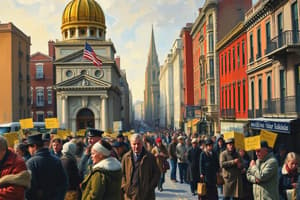Podcast
Questions and Answers
What was the percentage of Americans living in urban areas by 1900?
What was the percentage of Americans living in urban areas by 1900?
- 17%
- 30%
- 40% (correct)
- 50%
What is the term used to describe the concentration of people into cities?
What is the term used to describe the concentration of people into cities?
- Industrialization
- Migration
- Urbanization (correct)
- Capitalism
How many immigrants flooded Northern American cities around the turn of the century?
How many immigrants flooded Northern American cities around the turn of the century?
- 25 million (correct)
- 15 million
- 10 million
- 20 million
Which of the following statements best describes the living conditions in the cities during urbanization?
Which of the following statements best describes the living conditions in the cities during urbanization?
Which two individuals are mentioned as examples of success stories from urban migration?
Which two individuals are mentioned as examples of success stories from urban migration?
Flashcards
Urbanization in America
Urbanization in America
The process of people moving from rural areas to cities, leading to significant city population growth.
American City Growth (1860-1910)
American City Growth (1860-1910)
Rapid increase in the American population concentrated in urban areas and an increase by nearly 3x by 1910.
Rural to Urban Migration
Rural to Urban Migration
Movement of people from rural areas (farms) to cities in search of better economic opportunities.
Immigration to US Cities
Immigration to US Cities
Signup and view all the flashcards
American Dream
American Dream
Signup and view all the flashcards
Study Notes
US Urbanization in the Late 1800s and Early 1900s
- Rapid Urban Growth: Between the Civil War and 1900, the percentage of Americans living in cities increased significantly, from 17% to 40%.
- Large Cities Emerge: Cities like Philadelphia, Chicago, and New York City experienced massive population growth, with New York exceeding two million residents.
- Rural to Urban Migration: Technological advancements in agriculture made farming more efficient, forcing many farmers to seek opportunities in cities. This was a major contributor to urban growth, along with immigration (as noted below).
- Immigration Influx: Over 25 million immigrants from Europe, Russia, and Asia flooded Northern American cities around the turn of the 20th century.
- "American Dream": Despite hardships, cities offered potential for upward mobility, including examples like Henry Frick and Andrew Carnegie.
Problems of Urbanization
- Overcrowding: Rapid population growth outpaced housing construction, leading to cramped, dangerous living conditions.
- Infrastructure Deficiencies: Insufficient infrastructure for sanitation, waste management, and public safety existed or was inadequate to handle the growing population.
- Poor Living Conditions: Tenements and other buildings lacked basic necessities like running water, sanitation, and proper ventilation. "Dumbbell tenements" were notorious examples, with shared shafts for ventilation becoming sanitation issues.
- Crime and Violence: Crime and violence flourished in poverty-ridden slums, often exacerbated by tensions between ethnic groups.
- Disease: Contaminated water, poor sanitation, and overcrowding led to widespread disease outbreaks (influenza, smallpox, cholera, dysentery, tuberculosis, typhoid) in the cities.
- Environmental Pollution: Air and water quality were compromised by industrial pollution, animal waste, and garbage.
Responses to Urban Problems
- Muckrakers: Investigative journalists like Jacob Riis exposed the problems of urban life, contributing to public awareness.
- Reform Movements: Citizens, politicians, and the Progressive Movement began to address urban issues.
- Urban Planning: A new discipline of urban planning emerged, developing long-term solutions for city problems, leading to improved services, public transportation and the creation of parks and conservation efforts.
- Improved Housing Codes: Updated building codes aimed to improve safety and sanitation in tenement buildings, including the requirement for each room to have a window to the outside.
- New Infrastructure: Sewer systems, clean water, paved roads were implemented to improve public health and sanitation in cities, reducing disease spread.
- Improvement of Public Transportation in New York City: Horse-drawn carriages, buses, cable cars, trolleys, elevated train lines, and eventually subways, helped alleviate congestion and pollution, allowing for expansion beyond Manhattan.
Urban Planning's Role in shaping American Cities
- Urban Planning Solutions: Helped create better housing, including running water, fire safety, and courtyards versus the previous problems highlighted.
- Conservation Efforts: Conservation groups promoted public parks, further improving city living conditions.
- Public Health Improvements: Urban planning led to better water treatment, garbage collection, public health services, and schools.
- Increased access to resources for different populations: improved public transportation allowed easier access to work, shopping, and leisure areas for residents, making the city more livable for everyone.
Studying That Suits You
Use AI to generate personalized quizzes and flashcards to suit your learning preferences.





